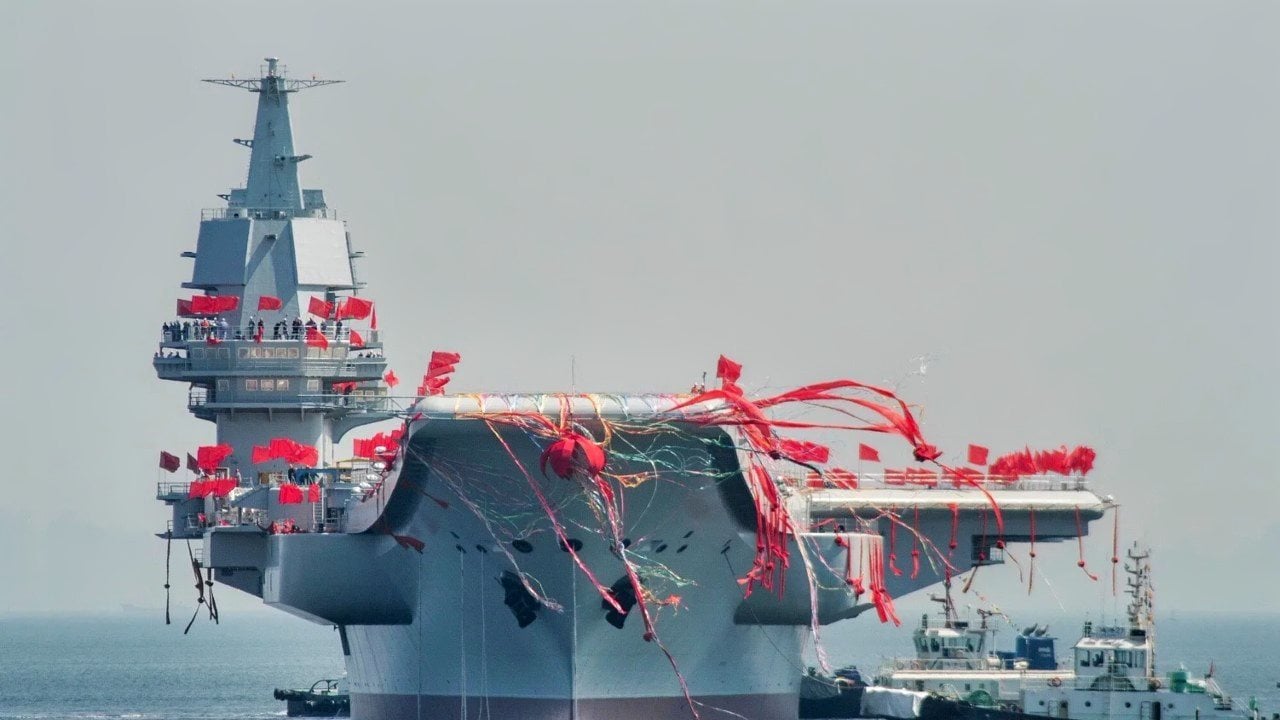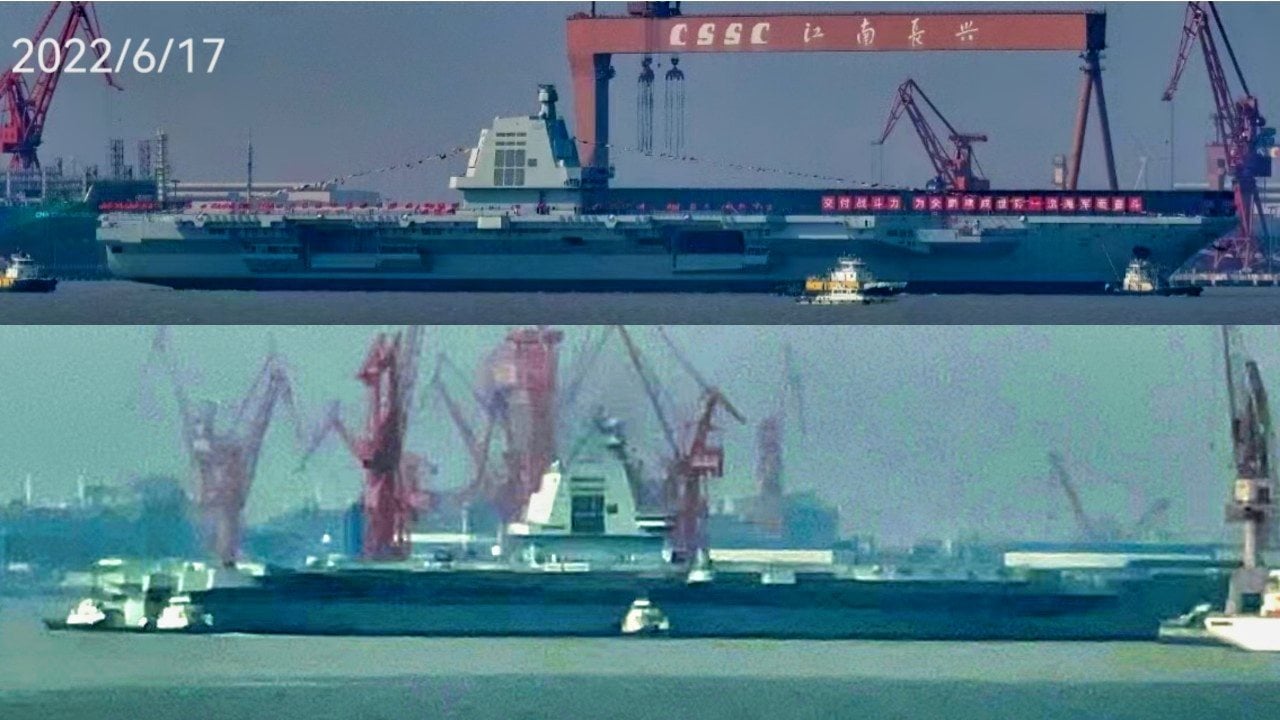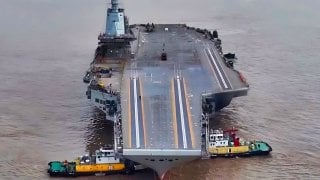China's Fleet of Aircraft Carriers Just Keeps Getting Bigger and Deadlier
China's Type 003 Fujian, the People's Liberation Army Navy's latest aircraft carrier, recently returned to Shanghai's Jiangnan Shipyard after completing its first eight-day sea trial.
Summary: China's Type 003 Fujian, the People's Liberation Army Navy's latest aircraft carrier, recently returned to Shanghai's Jiangnan Shipyard after completing its first eight-day sea trial. As the nation's third carrier and the first Chinese vessel with electromagnetic aircraft launch system (EMALS), similar to the U.S. Navy's Gerald R. Ford-class carriers, the Fujian marks a significant advancement in China's naval capabilities.

-The 80,000-ton carrier tested its propulsion and electrical systems and is expected to host advanced aircraft like the J-35 stealth fighter and KJ-600 early warning aircraft.
-Although the Fujian represents a leap in technological sophistication, it still trails behind the U.S. Ford-class carriers in terms of size, endurance, and support infrastructure. Experts predict several more months of sea trials before it can commence flight operations, and it will be some time before the carrier is fully operational.
The People's Liberation Army Navy’s (PLAN’s) Type 003 Fujian was back in port at the Shanghai Jiangnan Shipyard on May 9 after completing an eight-day sea trial. Images of China's newest aircraft carrier, taken by Planet Labs and obtained by Radio Free Asia, showed the vessel moving back to the berth where it was built and fitted out over the past six years.
The warship's maiden sea trial began on May 1. The carrier reportedly tested its propulsion and electrical systems, as well as other equipment.
The 80,000-ton Type 003 Fujian is China's third aircraft carrier and the first to be equipped with electromagnetic catapults for launching aircraft. It is the only flattop apart from the U.S. Navy's Gerald R. Ford-class nuclear-powered supercarriers to be outfitted with the electromagnetic aircraft launch system, or EMALS.
According to the Chinese state-run Global Times, the Type 003 Fujian is expected to operate not only improved versions of the J-15 fighter jet, but also new aircraft including the next-generation stealth fighter J-35, the fixed-wing early warning aircraft KJ-600, and the JL-10 advanced trainer jet.
Named after East China's Fujian Province, the carrier was launched in June 2022. It has already undergone mooring trials, outfitting work, and equipment tests in preparation for its sea trials.
More Tests to Come
The eight-day sea trials are just the beginning of many more tests that will take place over the summer and into the fall.
"If previous experience is any guide, we can expect three to five months of sea trials to ensure the integrity of the hull and propulsion systems," Robert Farley, a senior lecturer at the University of Kentucky, told Radio Free Asia. "If everything goes well, Fujian could begin flight operations this year."
It would still be a year or more before the carrier can be considered operational, Farley added.
China's Next Aircraft Carrier
In just over a decade, the People's Republic of China has made a great leap forward in aircraft carrier development. The PLAN's first aircraft carrier, the Type 001 Liaoning, a refurbished Soviet carrier, was commissioned in 2012. The second carrier, the Type 002 Shandong, was launched in 2017.
Beijing is expected to soon reveal plans for its fourth aircraft carrier. Speculation abounds that the next carrier could be nuclear-powered, indicating that China will continue to improve its naval capabilities.
After the addition of the Type 003 Fujian, China has the second-largest carrier fleet in the world after the U.S. Navy, which operates 10 Nimitz-class and one Gerald R. Ford-class nuclear-powered supercarriers. In the coming decades, the Navy will replace its aging Nimitz-class carriers on a one-for-one basis with the newer Ford class. There have also been calls to expand the size of the carrier force by keeping the existing carriers in service longer.
With the retirement of the USS Kitty Hawk in 2009, the U.S. Navy no longer operates conventionally powered carriers.
How Does it Stack Up?
Military analysts note Beijing’s progress on aircraft carrier designs, but stress that the Type 003 carrier still lags behind the capabilities of the USS Gerald R. Ford (CVN-78), the Navy's newest carrier.
"Fujian is smaller, about 80,000 tonnes versus 100,000 tonnes for the Ford-class, which means it will carry fewer aircraft. Also, Ford-class ships are nuclear-powered and Fujian is not, which means Fujian will have less endurance and less space on board for aviation fuel," Sam Roggeveen, Director of the Australian think tank Lowy Institute's International Security Program, told Newsweek.
Building a ship is just the first step. Operating carriers requires a great deal of infrastructure and capabilities.
"[A] weakness is that China lacks the infrastructure to operate Fujian far from home for long periods. It has only a small fleet of replenishment ships of the kind that typically accompany a carrier fleet and keep it topped up with fuel, munitions and stores," Roggeveen added. "And China has nothing like America's vast global network of ports and bases where its carriers can be replenished, and crews can rest."

Of course, China’s fleet of carriers could be followed by a global network of ports. Beijing already has its eyes on that prize.
Author Experience and Expertise: Peter Suciu
Peter Suciu is a Michigan-based writer. He has contributed to more than four dozen magazines, newspapers, and websites with over 3,200 published pieces over a twenty-year career in journalism. He regularly writes about military hardware, firearms history, cybersecurity, politics, and international affairs. Peter is also a Contributing Writer for Forbes and Clearance Jobs. You can follow him on Twitter: @PeterSuciu. You can email the author: [email protected].


